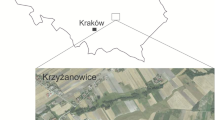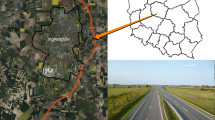Abstract
The reproduction of the plateau pika (Ochotona curzoniae) was investigated in Guoluo District at an elevation of 4,000 m on the Qinghai–Tibetan plateau, China, from April 2007 to August 2008. Reproduction was seasonal, and the breeding season lasted from April to late June/early July. Adults produced two litters in each year, and the mean litter size, estimated by counting the number of embryos in utero, was 3.3 ± 0.1 (n = 52) in 2007 and 3.2 ± 0.1 (n = 66) in 2008. The timing of reproduction showed high inter-annual variation; lower precipitation and the concomitant delay in spring vegetation phenology may have retarded the onset of the breeding season in 2007 compared with 2008. The most frequent litter sizes were 3 and 4, which together comprised 71.2% and 83.3% of litters in May and June of 2007 and 2008, respectively. Compared with previous studies, reproduction was highly variable between geographic areas. Pikas produced between one and five litters per year in different regions of the plateau over different breeding seasons. This geographic and inter-annual variation appeared to be associated with the duration of plant growth at each site, suggesting that plateau pikas adjust the length of their breeding season to match the period when sufficient energy is available to support the high energy demands of reproduction.






Similar content being viewed by others
References
Barnes AI, Partridge L (2003) Costing reproduction. Anim Behav 66:199–204
Both C (1998) Experimental evidence for density dependence of reproduction in great tits. J Anim Ecol 67:667–674
Charnov EL, Krebs JR (1974) On clutch size and fitness. Ibis 116:217–219
Degen AA, Khokhlova IS, Kam M, Snider I (2004) Water budget during reproduction in female common spiny mice (Acomys cahirinus). J Mammal 85:1106–1110
Ding XT, He XQ, Chao YQ, Li FM, Xie WB (2000) Preliminary studies on the breeding and population renew of plateau pika in Ganzi Autonomous Prefecture. Sichuan Anim Vet Sci 27:54–55
Dobson FS, Smith AT, Wang XG (1998) Social and ecological influences on dispersal and philopatry in the plateau pika (Ochotona curzoniae). Behav Ecol 9:622–635
Dobson FS, Smith AT, Wang XG (2000) The mating system and gene dynamics of plateau pikas. Behav Proc 51:101–110
Frick WF, Reynolds DS, Kunz TH (2010) Influence of climate and reproductive timing on demography of little brown myotis Myotis lucifugus. J Anim Ecol 79:128–136
Harshman LG, Zera AJ (2007) The cost of reproduction: the devil in the detail. Trends Ecol Evol 22:80–86
Johnson MS, Thomson SC, Speakman JR (2001) Limits to sustained energy intake: I. Lactation in the laboratory mouse Mus musculus. J Exp Biol 204:1925–1935
Koskela E (1998) Offspring growth, survival and reproductive success in the bank vole: a litter size manipulation experiment. Oecologia 115:379–384
Krebs CJ, Kenney AJ, Singleton GR, Mutze G, Pech RP, Brown PR, Davis SA (2004) Can outbreaks of house mice in south-eastern Australia be predicted by weather models? Wildlife Res 31:465–474
Li ZW, Sun RY, Du JZ (1998) Seasonal reproductive cycles in male plateau pika (Ochotona curzoniae). Acta Their Sin 18:42–49
Li QF, Sun RY, Huang CX, Wang ZK, Liu XT, Hou JJ, Liu JS, Cao LQ, Li N, Zhang SZ, Wang Y (2001) Cold adaptive thermogenesis in small mammals from different geographical zones of China. Comp Biochem Physiol A 129:949–961
Li YN, Zhao XQ, Cao GM, Zhao L, Wang XQ (2004) Analyses on climates and vegetation productivity background at Haibei Alpine Meadow Ecosystem Research Station. Plateau Meteorol 23:558–567
Liang JR (1981) Family structure of plateau pika (Ochotona curzoniae). Acta Their Sin 1:159–165
Liu H, Wang DH, Wang ZW (2003) Energy requirements during reproduction in female Brandt’s voles (Microtus brandtii). J Mammal 84:1410–1416
Luosang JC (2002) Study of plateau pika in Naqu. Tibet Anim Vet Sci 1:12–14
Mappes T, Koskela E, Ylönen H (1995) Reproductive costs and litter size in the bank vole. Proc R Soc Lond B 261:19–24
Masters P (1993) The effects of fire-driven succession and rainfall on small mammals in spinifex grassland at Uluru National Park, Northern Territory. Wildlife Res 20:803–813
McElligott AG, Altwegg R, Hayden TJ (2002) Age-specific survival and reproductive probabilities: evidence for senescence in male fallow deer (Dama dama). Proc R Soc Lond B 269:1129–1137
Millar JS (1973) Evolution of litter-size in the pika, Ochotona princeps (Richardson). Evol 27:134–143
Millar JS (1977) Adaptive features of mammalian reproduction. Evol 31:370–386
Morris DW (1986) Proximate and ultimate controls on life-history variation: the evolution of litter size in white-footed mice (Peromyscus leucopus). Evol 40:169–181
Morris DW (1992) Optimum brood size: tests of alternative hypotheses. Evol 46:1848–1861
Nie HY (2005) Study on the evolutionary ecology of small herbivorous mammals: life history strategy of plateau pika (Ochotona curzoniae). Dissertation, Zhejiang University
Qu JP, Li KX, YangM LiWJ, Zhang YM, Smith AT (2007) Seasonal dynamic pattern of spacial territory in social groups of plateau pikas (Ochotona curzoniae). Acta Their Sin 27:215–220
Qu JP, Yang M, Li WJ, Li KX, Zhang YM, Smith AT (2008) Seasonal variation of family group structure of plateau pikas (Ochotona curzoniae). Acta Their Sin 28:144–150
Santos P, Fernández-Llario P, Fonseca C, Monzón A, Bento P, Soares AMVM, Mateos-Quesada P, Petrucci-Fonseca F (2006) Habitat and reproductive phenology of wild boar (Sus scrofa) in the western Iberian Peninsula. Eur J Wildlife Res 52:207–212
Schorr RA, Lukacs PM, Florant GL (2009) Body mass and winter severity as predators of overwinter survival in preble’s meadow jumping mouse. J Mammal 90:17–24
Shen SY, Chen YG (1984) Preliminary research on ecology of the plateau pika at Dawu area, Guoluo, Qinghai Province. Acta Their Sin 4:107–115
Singleton G, Krebs CJ, Davis S, Chambers L, Brown P (2001) Reproductive changes in fluctuating house mouse populations in southeastern Australia. Proc R Soc Lond B 268:1741–1748
Smith AT (1978) Comparative demography of pikas (Ochotona): effect of spatial and temporal age-specific mortality. Ecol 59:133–139
Smith AT (1988) Patterns of pikas (genus Ochotona) life history variation. In: Boyce MS (ed) Evolution of life histories: theory and patterns from mammals. Yale University Press, New Haven, pp 233–256
Smith AT, Ivins BL (1983) Reproductive tactics of pikas: why have two litters? Can J Zool 61:1551–1559
Smith AT, Wang XG (1991) Social relationships of adult black-lipped pikas (Ochotona curzoniae). J Mammal 72:231–247
Smith AT, Xie Y (2008) A guide to the mammals in China. Princeton University Press, Princeton
Speakman JR (2008) The physiological costs of reproduction in small mammals. Philos Trans R Soc B 363:375–398
Wang XG, Dai KH (1991) Studies on the population reproduction ecology of plateau pika. Zool Res 12:155–161
Wang CT, Wang QJ, Long RJ, Jing ZC, Shi HL (2004a) Changes in plant species diversity and productivity along an elevation gradient in an alpine meadow. Acta Phytoec Sin 28:240–245
Wang JL, Wei WH, Zhang YM, Yin BF, Cao YF (2004b) The sex ratio of plateau pika’s population. Acta Their Sin 24:177–181
Wang JM, Zhang YM, Wang DH (2006) Seasonal thermogenesis and body mass regulation in plateau pikas (Ochotona curzoniae). Oecologia 149:373–382
Yang YH, Piao SL (2006) Variations in grassland vegetation cover in relation to climate factors on the Tibetan plateau. J Plant Ecol 30:1–8
Yang J, Zhao XQ, Guo SC, Li HG, Qi DL, Wang DP, Cao JH (2006) Leptin cDNA cloning and its mRNA expression in plateau pikas (Ochotona curzoniae) from different altitudes on Qinghai–Tibet plateau. Biochem Biophysical Res Commun 345:1405–1413
Yang YZ, Cao Y, Jin GE, Bai ZZ, Lan M, Yun HX, Ge RL (2007) Molecular cloning and characterization of hemoglobin at and chains from plateau pika (Ochotona curzoniae) living at high altitude. Gene 403:118–124
Yang K, Lin ED, Gao QZ, Wan YF, JiangCun WZ, Wang BS, Li WF (2010) Simulation of climate change impacts on grassland productivity in Northern Tibet. Chin J Ecol 29:1469–1476
Yin BF, Yang SM, Wei WH, Zhang YM (2009) Male reproductive success in plateau pikas (Ochotona curzoniae): a microsatellite analysis. Mamm Biol 74:344–350
Ylönen H, Jacob J, Runcie MJ, Singleton GR (2003) Is reproduction of the Australian house mouse (Mus domesticus) constrained by food? A large-scale field experiment. Oecologia 135:372–377
Yu N, Zheng CL, Zhang YP, Li WH (2000) Molecular systematics of pikas (genus Ochotona) inferred from mitochondrial DNA sequences. Mol Phylogenet Evol 16:85–95
Zhang ZH, Liu RT (1996) Study of reproduction and population dynamics of platau pika. Gansu Agr Techn 3:30–32
Zhong C, Wei P (2010) Effect of weather change on crops growth in Guinan county of Qinghai Province. Guizhou Agr Sci 38:75–78
Acknowledgments
This work was supported by Key Innovation Research Programs of the Chinese Academy of Sciences (no. KSCX2-YW-N-06, KSCX2-YW-N-90) and grants from the “973” Project of China Ministry of Science and Technology (no. 2007CB109105). We thank the editor and two anonymous reviewers for their invaluable comments. We thank Zhibin Zhang and John R. Speakman for comments on earlier drafts of the manuscript. This study could not have been completed without the friendly help of local people in Guoluo. Our experiments complied with the laws of China.
Author information
Authors and Affiliations
Corresponding author
Additional information
Communicated by C. Gortázar
Rights and permissions
About this article
Cite this article
Qu, J., Liu, M., Yang, M. et al. Reproduction of plateau pika (Ochotona curzoniae) on the Qinghai–Tibetan plateau. Eur J Wildl Res 58, 269–277 (2012). https://doi.org/10.1007/s10344-011-0574-2
Received:
Revised:
Accepted:
Published:
Issue Date:
DOI: https://doi.org/10.1007/s10344-011-0574-2




